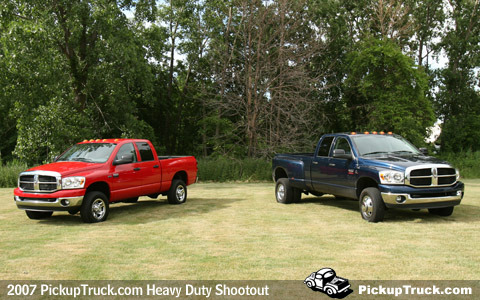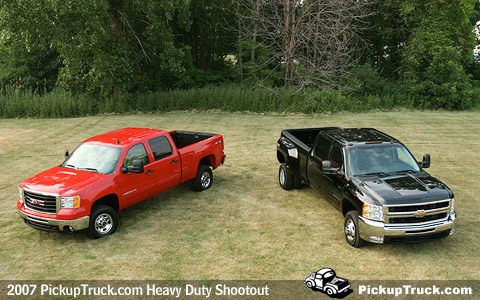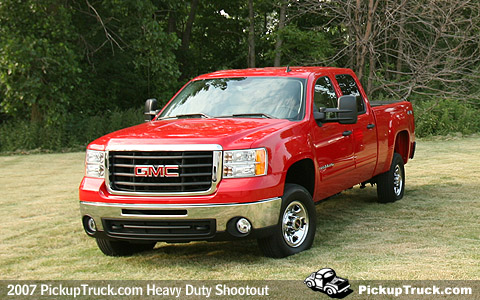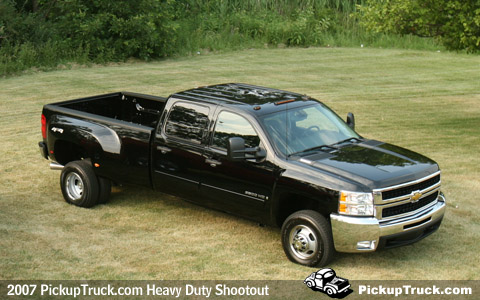2007 Dodge Ram 2500 SLT Quad Cab 4x4 There aren’t many changes this year for the 2007 Dodge Ram 2500 SLT Quad Cab we tested.The 5.7-liter HEMI V8 it came with is the standard engine for Dodge’s three-quarter-ton pickup. In this truck it’s rated at 345-horsepower but in the 3500 it’s slightly detuned to 330-hp in the Regular and Quad Cab models. The HEMI had the least horsepower of the gas group, but at 1-horsepower per cubic-inch, it was the most powerful in proportion to engine volume. Like the Ford F-350, it had a five-speed automatic transmission, one gear less than the GMC’s new heavy duty six-speed.We’re hoping the next generation Ram HD turns up in 2009 when the new light duty Ram debuts. One of the items Chrysler Group VP Ralph Gilles has said he’d like to see improved is the interior and we can’t disagree. Relative to the Super Duty and GM Heavy Duty trucks, the Ram’s innards are very dated and in dire need of a boost in material quality and an ergonomic revamp.
Our truck came with an optional $2,620 DVD-based GPS navigation, CD, radio, and seven-speaker Infinity speaker audio system. Its confusing mix of buttons and lack of touch screen controls were much more difficult to use than the more functional $1,875 navi-CD-DVD-stereo combo in the Ford F-350 we drove.Neither Ram offers integrated electronic trailer brake controllers, like the GM and Ford trucks do. Ford’s had them since 2005 and they’re new this year for GM. You’ll have to choose an aftermarket solution for the Ram if you want to have any control over the gain (brake pressure) applied to help stop the trailer.Of all the trucks we tested, we felt the two Rams offered the most precise steering feel, required the least effort to control, and tracked best under load.2007 Dodge Ram 3500 SLT Quad Cab 4x4 Our dually Ram 3500 had the all new 6.7-liter Cummins I6 diesel under its hood, but the entire truck only cost $3775 more than the SRW Ram 2500. The lack of optional navigation accounts for a large portion of the lower than expected price difference. Given the value for the dollar – we emphatically recommend putting your hard earned money into ordering the Cummins in either the 2500 or 3500 without ever thinking about the navigation system. Even though the Cummins I6 has two less cylinders than the Ford and Chevrolet V8 diesels, it has a larger displacement than either of those engines. It has the same torque as the Ford and only ten lb-ft less than the Chevy. Peak torque is available in the lowest rpm range of the three pickups. When we started it up, the Ram visibly shivered from all of the torque as the Cummins cranked over.
Like the Allison equipped Chevrolet Silverado we drove, the Dodge Ram 3500 also came with a six-speed transmission. But this is a ‘modified’ version of the five-speed transmission found in the HEMI powered 2500 pickup. It’s not the more highly regarded Aisin Seiki-sourced six-speed that’s mated to the Cummins in the new Ram 3500 chassis cab. Like the GM pickups, there's a new toggle switch on the shift stem to manually upshift or downshift the transmission, so drivers can manage the automatic gearbox like a manual. The Dodge Ram 3500 also has two unique advantages over the Ford and Chevy trucks. First, not only do the Cummins’ soot output levels meet and exceed 2010 Tier 2 Bin 5 particulate emission standards, but so do its NOX emissions. While Ford and GM are still trying to figure out how they’ll use urea selective catalytic reduction (SCR) to lower NOX, Chrysler is using Cummins’ urea-free “adsorber” catalyst which soaks up stray NOX molecules without any regular maintenance or refills. The adsorber catalyst uses some very rare metals to do its job, so there’s a risk that the price for the Cummins could go up with the cost of these metals if they rise in the market. Second, the Ram is the only heavy duty pickup that offers an integrated exhaust brake, similar to the engine brakes commercial big rigs have. Activated with the push of a button, this feature saves on brake and transmission wear by closing down the engine’s turbo vanes to restrict airflow to engine brake the truck. It also reduces the potential for brake fade during long descents, increasing downhill safety while towing. Medium Duty C4500/5500 GM trucks also offer factory exhaust brakes, so perhaps we’ll see this feature show up next on the HD Sierra and Silverado. The HD power contest may turn into a stopping contest, because with trucks able to tow larger trailers with ease comes the responsibility to stop more weight safely. |
|
2007 GMC Sierra 2500 SLE Crew Cab 4x4 The GMC and Chevrolet heavy duty pickups are all new for 2007. Our GMC Sierra came with the new 6.0-liter Vortec V8 gas engine that’s the standard power plant for GM’s three-quarter and one-ton pickups. It’s also the only gas heavy duty engine to offer variable valve timing and the first to have a heavy duty six speed automatic transmission. The extra gear it carries over the Ford and Dodge is aimed at providing improved fuel economy. The ‘pure pickup’ interior of our Sierra had excellent fit and finish for a mid-grade trimmed heavy duty. The gaps between instrument, audio, and HVAC components were the tightest and best aligned of all the trucks. The Sierra also came with an automatic mechanical locking rear differential. The other two trucks only come with limited slip clutches in their back diffs.
Our suggested improvement to GM for this truck – make the gas tank bigger. In the short box configuration it was the smallest in the group at only 26 gallons. The Sierra may have the best EPA-rated fuel economy of the trucks we tested, but this truck really needs at least four more gallons of capacity to extend towing range. There’s a handy low-tech assist from GM on the Sierra (and Silverado) to help frequent tow-ers. Like the Fords, the Sierra has a 2.5-inch Class V trailer hitch receiver. But if you only need 2-inch Class IV hitch, the Sierra comes with a reducer sleeve to shrink the receiver’s diameter. Again, same as the Fords. What’s cool about the Sierra’s reducer, though, is that it has a ‘lip’ around the edges, so when you’re holding a hitch pin in one hand and a hitch shank/reducer combo in the other, you won’t have to worry about aligning the holes in the receiver and shank to thread the pin through. The lip physically indexes the hole alignments for you as you slide the shank into the receiver. The Fords don’t have lips on their reducers, so you have to spend time holding and sliding heavy shanks back and forth to manually align the holes in the receiver, reducer, and shank. That can be tiring, very quickly.
The GMC was also the cheapest truck of our entire test fleet, at $36,693. That’s a good deal. 2007 Chevrolet Silverado 3500 LT Crew Cab 4x4 Even after seven years on the market, and four iterations, it’s tough to beat the well-integrated Duramax / Allison combination we had in our Silverado 3500. It took the pole position as the most powerful oil burner amongst our three one-tons, at 365-hp and 660 lb-ft of torque. One of our testers was so enamored with the powertrain we had to pry him out of the truck to drive the others, or grab the keys to this crew cab before he could grab them. GM has made several significant changes to the Duramax architecture for 2007 – to improve durability and meet the new emissions requirements. It has a new ‘boreless’ turbo that allows the turbo shaft to be screwed directly into the compressor wheel instead of passing through it. New fuel injectors allow for precise application of fuel up to five times during a single combustion stroke, reducing engine clatter and dynamically optimizing ignition to combustion conditions.
NOX emissions have been reduced by adding a larger exhaust gas recirculation (EGR) cooler and closed crankcase to contain engine gasses inside the motor. Like the Dodge and Ford pickups, the Silverado also adds a diesel particulate filter (DPF) that requires periodic self-cleaning regeneration to burn off trapped soot. The sinister looking black dually we drove also had a black cloth interior, with the ‘pure pickup’ dash and IP that’s so appropriate for a work truck like this. It was intuitive and ergonomically spot on. Our biggest gripe about this truck was the placement of the integrated trailer brake controller. It’s low and on the left-side of the dash. Almost all aftermarket trailer brake controllers are added to the driver’s right side, higher up. Some drivers may struggle to automatically find the unit when they need to quickly increase gain. Another observation about this dually, and the others, was how well mannered the truck was unloaded. The rear wheels stayed well planted on almost all road surfaces, mercifully giving driver and passengers a comfortable ride. We would have been bounced to oblivion in an unloaded dually 20 years ago. |






